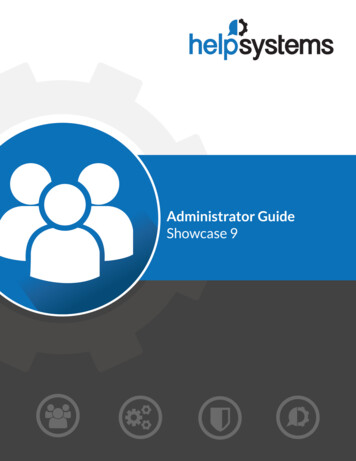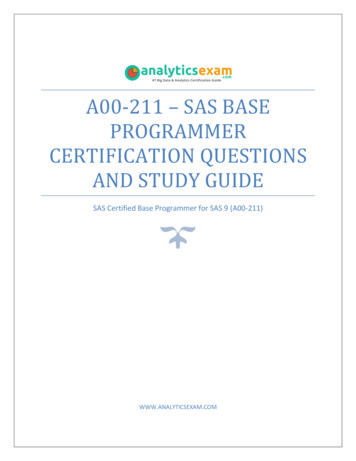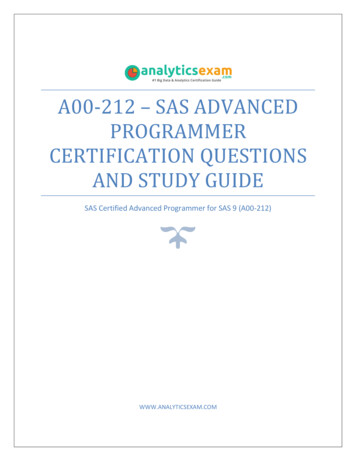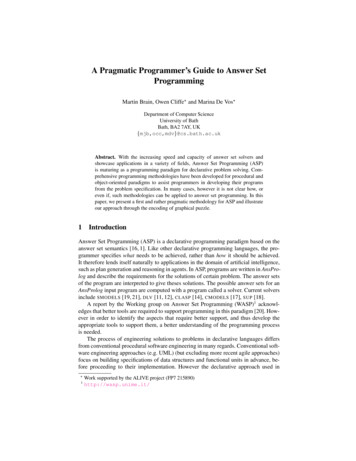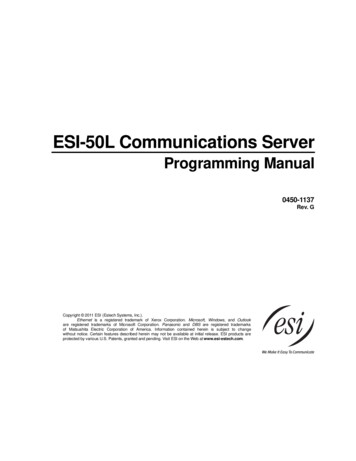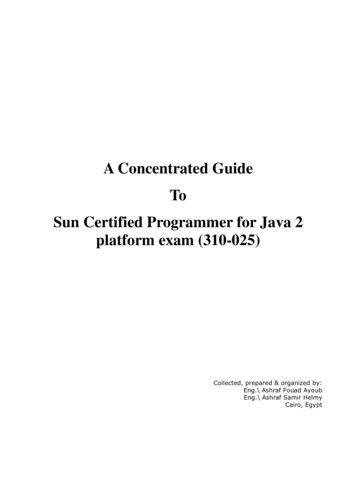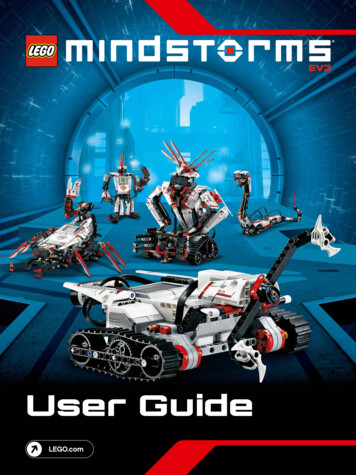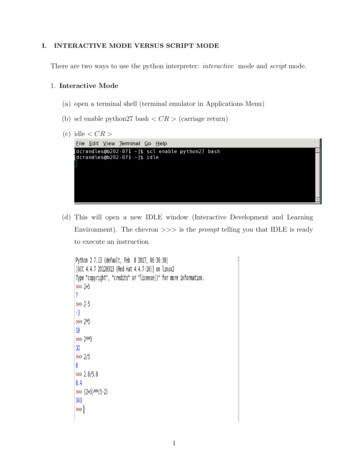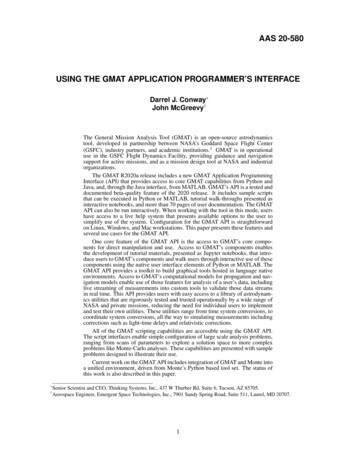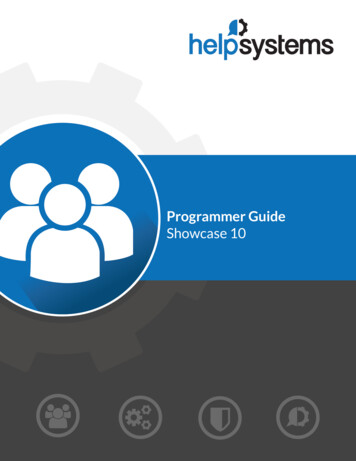
Transcription
Programmer GuideShowcase 10
Copyright Terms and ConditionsThe content in this document is protected by the Copyright Laws of the United States of America and other countries worldwide. The unauthorized use and/or duplication of this material without express and written permission from HelpSystems isstrictly prohibited. Excerpts and links may be used, provided that full and clear credit is given to HelpSystems with appropriate and specific direction to the original content. HelpSystems and its trademarks are properties of the HelpSystems groupof companies. All other marks are property of their respective owners.201811145946www.helpsystems.comAbout HelpSystemsHelpSystems is a leading provider of systems & networkmanagement, business intelligence, and security & compliancesoftware. We help businesses reduce data center costs byimproving operational control and delivery of IT services. HelpSystems, LLC. All rights reserved. All trademarks and registered trademarks are the property of their respective owners.
About This GuideThis manual is intended for programmers and database administrators that use the Showcasedata retrieval system.It is a reference manual that provides technical information about Showcase’s components (kernel, view editor, report writer, tables and scripting) and how they work.This manual is divided into several sections:Part 1 is introductory and describes the basic structure of Showcase and its functions.Part 2 documents the syntax for each Showcase command and their parameters.Part 3 describes the extra “layer” of security that is afforded by the exclusion dictionary. It letsyou establish file and field level security for users with access to the user interface. You canrestrict them from creating and running views over files or fields that should be protected without affecting the normal operations of their current programs.Part 4 gives programming examples and additional information about creating and using run–time prompted views.Part 5 provides documentation about the data modification capabilities of Showcase. It showshow to use the UPDATE, INSERT, and DELETE commands. A discussion of commitment control and how it can be used effectively is also included.Part 6 discusses the performance considerations associated with Showcase requests. It alsooffers some ideas that may help you measure and improve the performance of your views andreports.Part 7 catalogs some important Showcase objects and considerations for the “extra” authorityrequirements of USRPRF(*OWNER) programs and system objects.The Appendix discusses Dynamic SQL which is a utility used within our BLDJDELF commandwhich builds logical files over JD Edwards files.The Index at the back of this manual provides a cross reference of all of the important topics.Use it to quickly locate the information that you need.Additional informationLess technical aspects of Showcase are documented in the Showcase SQL Reference Guide. Youcan refer to it for general information about each part of the Showcase system and how to use it.About This Guideiii
ivShowcase 10 Programmer’s Guide - About This Guide
ContentsIntroduction . . . . . . . . . . . . . . . . . . . . . . . . . . . . . . . . . . . . . . . . . . . . . . . . . . . . . . . 1-1Components of Showcase . . . . . . . . . . . . . . . . . . . . . . . . . . . . . . . . . . . 1-2Features of Showcase . . . . . . . . . . . . . . . . . . . . . . . . . . . . . . . . . . . . . . 1-5Showcase Objects . . . . . . . . . . . . . . . . . . . . . . . . . . . . . . . . . . . . . . . . . 1-7How to Contact Sequel Software . . . . . . . . . . . . . . . . . . . . . . . . . . . . . 1-10Command Reference . . . . . . . . . . . . . . . . . . . . . . . . . . . . . . . . . . . . . . . . . . . . . . . 2-1ANZAUDDTA (Analyze Audit Data) Command . . . . . . . . . . . . . . . . . . . 2-6BCHEXECUTE (Submit Execute To Batch) Command . . . . . . . . . . . . . 2-7BCHPRINT (Submit Print To Batch) Command . . . . . . . . . . . . . . . . . . . 2-8BCHREPORT (Submit A Sequel Report) Command . . . . . . . . . . . . . . . 2-9BCHSCRIPT (Submit A Sequel Script) Command . . . . . . . . . . . . . . . . 2-10BLDJDELF (Build view from JDE definition) Command . . . . . . . . . . . . 2-11BLDOPTF (Build Option File) Command . . . . . . . . . . . . . . . . . . . . . . . 2-14CHGAUTMODE (Change Authorization Mode) Command . . . . . . . . . 2-16CHGVIEW (Change View Definition) Command . . . . . . . . . . . . . . . . . 2-17CHGRPTD (Change Report Description) Command . . . . . . . . . . . . . . 2-23CHGTBLD (Change Table Description) Command . . . . . . . . . . . . . . . 2-26CRTDASHLNK (Create Dashboard Link) Command . . . . . . . . . . . . . . 2-27CRTSCRIPT (Create Script) Command . . . . . . . . . . . . . . . . . . . . . . . . 2-29CRTVIEW (Create View) Command . . . . . . . . . . . . . . . . . . . . . . . . . . 2-34CVTPDMFSQL (Convert PDM File to Sequel) Command . . . . . . . . . . 2-45CVTQRY (Convert Query) Command . . . . . . . . . . . . . . . . . . . . . . . . . 2-46CVTRPT (Convert Report Format) Command . . . . . . . . . . . . . . . . . . . 2-49CVTSQTOIFS (Convert Sequel Objects to IFS) Command . . . . . . . . . 2-50CVTSYNTAX (Convert Syntax) Command . . . . . . . . . . . . . . . . . . . . . 2-52CVTVIEW (Convert View) Command . . . . . . . . . . . . . . . . . . . . . . . . . . 2-53CVTWHBLDR (Convert Warehouse Builder) Command . . . . . . . . . . . 2-54DELETE (Delete Records With a View) Command . . . . . . . . . . . . . . . 2-56DISPLAY (Display View Data) Command . . . . . . . . . . . . . . . . . . . . . . 2-60DLTAUDDTA (Delete Audit Data) Command . . . . . . . . . . . . . . . . . . . . 2-63DSNREPORT (Design A Sequel Report) Command . . . . . . . . . . . . . . 2-66DSNSCRIPT (Design a Sequel Script) Command . . . . . . . . . . . . . . . . 2-70DSNTABLE (Design A Sequel Table) Command . . . . . . . . . . . . . . . . . 2-73DSNVIEW (Design A Sequel View) Command . . . . . . . . . . . . . . . . . . 2-75DSPDASHD (Display Dashboard Description) Command . . . . . . . . . . 2-77DSPRPTD (Display Report Description) Command . . . . . . . . . . . . . . . 2-81DSPSCRIPTD (Display Script Definition) Command . . . . . . . . . . . . . . 2-86DSPTBLD (Display Table Description) Command . . . . . . . . . . . . . . . . 2-90Contentsv
DSPVIEWD (Display View Description) Command . . . . . . . . . . . . . . . 2-94EXECUTE (Execute To A File) Command . . . . . . . . . . . . . . . . . . . . . . 2-99EXECUTEVPT (Execute a VPT Object) Command . . . . . . . . . . . . . . 2-109GPHAUDSUM (Graph Audit Summary) Command . . . . . . . . . . . . . . 2-110INSERT (Insert Records Into A File) Command . . . . . . . . . . . . . . . . . 2-111LSTDCTOBJ (List Sequel Authority By Object) Command . . . . . . . . 2-117LSTDCTUSR (List Sequel Authority Dictionary By User) Command . . . . . . . . . . . . . . . . . . . . . . . . . . . . . . . . . . . . . . . . . . . . . . 2-118MGRSQLOBJ (Migrate Sequel Objects) Command . . . . . . . . . . . . . . 2-119MNTHOSTF (Sequel Host File Maintenance) Command . . . . . . . . . . 2-121OPNSQLF (Open Sequel File) Command . . . . . . . . . . . . . . . . . . . . . 2-122OUTFILE (Execute an SQL View) Command . . . . . . . . . . . . . . . . . . 2-127PRINT (Print Sequel Data) Command . . . . . . . . . . . . . . . . . . . . . . . . 2-128PRTAUDDTA (Print Audit Data) Command . . . . . . . . . . . . . . . . . . . . 2-132PRTAUDDTL (Print Audit Detail) Command . . . . . . . . . . . . . . . . . . . 2-134PRTAUDFIL (Print Audited File Usage) Command . . . . . . . . . . . . . . 2-135PRTAUDPTH (Print Audited Access Paths) Command . . . . . . . . . . . 2-136PRTRPTD (Print Report Description) Command . . . . . . . . . . . . . . . . 2-137PRTSEQUEL (Print Sequel Objects) Command . . . . . . . . . . . . . . . . 2-138REPORT (Run A Sequel Report) Command . . . . . . . . . . . . . . . . . . . 2-139REPORTVPT (Run a ViewPoint Report Object) Command . . . . . . . . 2-145RGZDCT (Reorganize Sequel Authority Dictionary) Command . . . . . 2-146RSMRPTDSN (Resume Report Design) Command . . . . . . . . . . . . . 2-147RTVRPTD (Retrieve Report Description) Command . . . . . . . . . . . . . 2-149RTVRPTSQL (Retrieve Report SQL) Command . . . . . . . . . . . . . . . . 2-152RTVTBLD (Retrieve Table Description) Command . . . . . . . . . . . . . . 2-154RTVTBLSQL (Retrieve Table SQL) Command . . . . . . . . . . . . . . . . . 2-156RTVVIEWD (Retrieve View Description) Command . . . . . . . . . . . . . 2-158RUNCMD (Run Commands Using Sequel Selection) Command . . . 2-161RUNCMDVPT (Run a Command Over All Records) Command . . . . 2-163RUNSCRIPT (Run Script) Command . . . . . . . . . . . . . . . . . . . . . . . . . 2-164RUNSCRVPT (Run a VPT Script Object) Command . . . . . . . . . . . . . 2-166SCHSCRIPT (Search Script) Command . . . . . . . . . . . . . . . . . . . . . . 2-167SCRETURN (Return Script View) Command . . . . . . . . . . . . . . . . . . . 2-169SEQSETJVAE (Set Sequel Java Environment) Command . . . . . . . . 2-172SETAUDDFT (Set Audit Default) Command . . . . . . . . . . . . . . . . . . . 2-173SETDFT (Set Sequel Defaults) Command . . . . . . . . . . . . . . . . . . . . . 2-174SETJDEOWA (Set Oracle JDE OneWorld / EnterpriseOne Attributes) Command . . . . . . . . . . . . . . . . . . . . . . . . . . . . . . . . . . . . . 2-176SQDATE (Add/Remove SQDATE data) Command . . . . . . . . . . . . . . 2-179SQLCLOSE (Sequel Close Connection) Command . . . . . . . . . . . . . . 2-182vi Showcase 10 Programmer’s Guide - Contents
SQLCONNECT (Sequel Connect) Command . . . . . . . . . . . . . . . . . .SQVER (Sequel Version) Command . . . . . . . . . . . . . . . . . . . . . . . . .STMFVARSUB (Stream File Variable Substitution) Command . . . . .TABLE (Execute To A File) Command . . . . . . . . . . . . . . . . . . . . . . . .UPDATE (Update Records In A File) Command . . . . . . . . . . . . . . . .VFYREPO (Verify Repository) Command . . . . . . . . . . . . . . . . . . . . .WRKAUDDTA (Work With Audit Data) Command . . . . . . . . . . . . . . .WRKAUDQRY (Work With Audit Data Query) Command . . . . . . . .WRKDCTOBJ (Work With Sequel Authority by Object . . . . . . . . . . .WRKDCTUSR (Work With Sequel Authority by User) Command . . .WRKPCFMT (Work With PC Formats) Command . . . . . . . . . . . . . . .WRKREPORT (Work With Reports) Command . . . . . . . . . . . . . . . . .WRKSEQUEL (Work With Sequel Objects) Command . . . . . . . . . . .WRKSCRIPT (Work With Scripts) Command . . . . . . . . . . . . . . . . . .WRKVIEW (Work With Views) Command . . . . . . . . . . . . . . . . . . . . 52-2062-2092-2102-2122-213Sequel Security . . . . . . . . . . . . . . . . . . . . . . . . . . . . . . . . . . . . . . . . . . . . . . . . . . . . 3-1Enabling Sequel Security . . . . . . . . . . . . . . . . . . . . . . . . . . . . . . . . . . . . 3-3Setting up the Authority Dictionary . . . . . . . . . . . . . . . . . . . . . . . . . . . . . 3-5Work With Sequel Authority By User . . . . . . . . . . . . . . . . . . . . . . . . 3-5Work With Sequel Authority By Object . . . . . . . . . . . . . . . . . . . . . 3-11Printing the Authority Dictionary . . . . . . . . . . . . . . . . . . . . . . . . . . . . . . 3-19List Authority Dictionary By User (LSTDCTUSR) Command . . . . . 3-19List Authority Dictionary By Object (LSTDCTOBJ) Command . . . . 3-20Reorganizing the Authority Dictionary . . . . . . . . . . . . . . . . . . . . . . . . . 3-21Customizing Sequel Security . . . . . . . . . . . . . . . . . . . . . . . . . . . . . . . . 3-22Sequel Programming . . . . . . . . . . . . . . . . . . . . . . . . . . . . . . . . . . . . . . . . . . . . . . . 4-1Simple View and Report Execution . . . . . . . . . . . . . . . . . . . . . . . . . . . . 4-3Variable Views . . . . . . . . . . . . . . . . . . . . . . . . . . . . . . . . . . . . . . . . . . . . 4-4ORDERSUMP Example . . . . . . . . . . . . . . . . . . . . . . . . . . . . . . . . . 4-11Runtime Prompt API . . . . . . . . . . . . . . . . . . . . . . . . . . . . . . . . . . . 4-15Program Created Statements and Views . . . . . . . . . . . . . . . . . . . . . . . 4-17Creating Sequel Statements Using String Concatenation . . . . . . . 4-17Using Existing Views as a Starting Point . . . . . . . . . . . . . . . . . . . . 4-18Execution Time Report Specification . . . . . . . . . . . . . . . . . . . . . . . . . . 4-21Submitting Requests . . . . . . . . . . . . . . . . . . . . . . . . . . . . . . . . . . . . . . 4-22Restricting Sequel Requests to the Batch Environment . . . . . . . . 4-22Submitting Variable Views . . . . . . . . . . . . . . . . . . . . . . . . . . . . . . . 4-23Processing Query Data with HLL Programs . . . . . . . . . . . . . . . . . . . . . 4-24Data Modification . . . . . . . . . . . . . . . . . . . . . . . . . . . . . . . . . . . . . . . . . . . . . . . . . . 5-1Commitment Control . . . . . . . . . . . . . . . . . . . . . . . . . . . . . . . . . . . . . . . 5-2Deleting Records . . . . . . . . . . . . . . . . . . . . . . . . . . . . . . . . . . . . . . . . . . 5-5Contentsvii
Changing Records . . . . . . . . . . . . . . . . . . . . . . . . . . . . . . . . . . . . . . . . . 5-8Creating Records . . . . . . . . . . . . . . . . . . . . . . . . . . . . . . . . . . . . . . . . . 5-11Performance . . . . . . . . . . . . . . . . . . . . . . . . . . . . . . . . . . . . . . . . . . . . . . . . . . . . . . 6-1Classic Query vs. SQL Query Engine . . . . . . . . . . . . . . . . . . . . . . . . . .Index Creation . . . . . . . . . . . . . . . . . . . . . . . . . . . . . . . . . . . . . . . . . . . .Processor Usage . . . . . . . . . . . . . . . . . . . . . . . . . . . . . . . . . . . . . . . . . .Execution Time . . . . . . . . . . . . . . . . . . . . . . . . . . . . . . . . . . . . . . . . . . . .6-16-26-36-4Sequel Objects . . . . . . . . . . . . . . . . . . . . . . . . . . . . . . . . . . . . . . . . . . . . . . . . . . . . 7-1SQLEXEC Output File . . . . . . . . . . . . . . . . . . . . . . . . . . . . . . . . . . . . . .SQLEXEC User Space . . . . . . . . . . . . . . . . . . . . . . . . . . . . . . . . . . . . . .Distribution of Sequel Output . . . . . . . . . . . . . . . . . . . . . . . . . . . . . . . . .Programs with USRPRF(*OWNER) . . . . . . . . . . . . . . . . . . . . . . . . . . . .SQLRQS Message Queue . . . . . . . . . . . . . . . . . . . . . . . . . . . . . . . . . . .Menu Driver Files . . . . . . . . . . . . . . . . . . . . . . . . . . . . . . . . . . . . . . . . . .7-17-17-27-37-57-6Appendix . . . . . . . . . . . . . . . . . . . . . . . . . . . . . . . . . . . . . . . . . . . . . . . . . . . . . . . . . A-1Dynamic SQL/400 Access/400 Access (DYNSQL) . . . . . . . . . . . . . . . .DYNSQL Objects . . . . . . . . . . . . . . . . . . . . . . . . . . . . . . . . . . . . . . .Using DYNSQL . . . . . . . . . . . . . . . . . . . . . . . . . . . . . . . . . . . . . . . .DYNSQL Restrictions . . . . . . . . . . . . . . . . . . . . . . . . . . . . . . . . . . .SQL/400 Statements Supported By DYNSQL . . . . . . . . . . . . . . . . .Examples . . . . . . . . . . . . . . . . . . . . . . . . . . . . . . . . . . . . . . . . . . . . .A-1A-1A-2A-3A-4A-8Index . . . . . . . . . . . . . . . . . . . . . . . . . . . . . . . . . . . . . . . . . . . . . . . . . . . . . . . . . . . . . . I-1viii Showcase 10 Programmer’s Guide - Contents
IntroductionShowcase from HelpSystems, provides information retrieval, report writing, and decision support for Power Systems running IBM i (System i, iSeries, and AS/400 systems). From simple adhoc queries to executive dashboards to providing information on the Web, Showcase deliversSystem i data in the format that works best for you. Without exception, Showcase is the fastestand easiest way to access your System i data.Showcase can obtain information from any database files that have been defined on your systemusing: Data description specifications (DDS) Interactive data definition utility (IDDU) Structured Query Language (SQL/400)The files can exist on your local system or on a remote System i, or on any other remote systemthat supports DDM, CLI or JDBC access. A partial list of such systems includes DB2, MicrosoftSQLServer, Oracle and MySQL. Any database that supports a type 2 JDBC driver is supported.Showcase lets you create your own view of the information you want to use, and then run theview in order to see the information on the display, send it to the printer, or store it in anotherdata file for later use. You can also route Showcase output to a shared folder document so that itcan be accessed from a personal computer using IBM iSeries Access.You can also use Showcase to create customized reports and tables that are formatted to yourexact specifications. Complex reports can be created using Showcase's report writing tools. Infact, Showcase can completely eliminate the need for most report programs! Showcase tables letyou summarize and categorize date quickly.You can use Showcase to obtain information from a single file or a combined set of up to 32files. You can select all the fields, or a few of the fields and organize them as you want them toappear. You can have all of the records in the file(s) included in your view or you can select onlya few.Showcase lets you use Structured Query Language (SQL) to create the views used in retrievingand formatting information. SQL is an internationally recognized standard language for manipulating data. It is in use in mainframe and micro computer applications throughout the world. It isalso available on the System i as a programming product from IBM.Showcase makes it possible for anyone familiar with the SQL language to work with databaseinformation, and helps teach SQL to those who are unfamiliar with it.All Showcase features can be accessed through the IBM i command interface. Anyone withaccess to a command entry line can use them simply by using the appropriate Showcase command. Users who do not have command entry privileges can still access Showcase using themenu. Because Showcase is command driven, it is easy to restrict authority to one or moreShowcase functions. Simply removing authority to the underlying Showcase command(s) prevents users from accessing the corresponding function.Introduction1-1
Components of ShowcaseShowcase consists of several components. These modules work together to supply the completeset of functions that Showcase provides.KernelThe heart of the system is the Showcase kernel. It supplies the commands that: Create, change, and document Showcase views Retrieve data through a view and route it to the workstation, printer, database file, or PCdocument Change data by updating, deleting, and inserting records through a view Support Showcase's runtime prompting and drill-down capabilities Organize views and reports so you can use them easily through "work with" displays andmenus Create, edit, and run Showcase scriptsIf the retrieved information is presented at the workstation, the Showcase data display lets you:Create multiple side-by-side windows on your displayScroll sequentially through the informationPosition vertically (by column) and horizontally (by row)Position horizontally by keyRun additional views or commands that use data values on the displayThe basic Showcase printouts are simply listings of the information in your view. You specifythe paper width (in columns) and length (in lines) and Showcase places the data onto the outputqueue for printing. If the view width exceeds the page width, Showcase will print on up to eightpages so the reports can be placed side by side and form a complete picture of the data. Thistechnique allows up to 1,584 columns (198 x 8) of data to be printed in an easy to interpret fashion.View EditorThe Showcase user interface provides an interactive view editor that lets you create and runrequests. It will assist people who do not know the SQL syntax or are unfamiliar with the database. It can also provide a procedural, step-by-step approach to view design and execution.The user interface can be tailored to your capabilities by choosing an assistance level that bestmeets your needs. Each Showcase user can choose one of three levels (basic, intermediate,advanced) that will determine the level of automatic prompting and advanced function that isavailable while using the user interface.Showcase's view editor can provide a series of displays to guide you through all parts of the SQLstatement to the successful creation of even complicated queries. Extensive on-line help is available from each display. It helps reduce confusion and makes the program even easier to use.1-2Showcase 10 Programmer’s Guide - Introduction
The user interface is designed so that virtually everyone who has access to the system can get theinformation they need through Showcase.At the same time, the user interface teaches the fundamentals of the SQL language. It helps usersto gain more knowledge of SQL and become familiar with the system. As they gain experienceand need less assistance, the software allows them to be more and more independent - providinghelp only when requested.Advanced users will appreciate the fact that the user interface does not force them to work at theslower pace of a beginner. Showcase offers a fast path prompter, assisting only when requested,and a full screen view editor, complete with advanced cut and paste features!Report WriterThe Showcase report writing module gives you the ability to design and create printed reportsthat are formatted exactly the way you want them.Standard printouts provided by the kernel functions will be sufficient for a wide variety of applications. More complex output requires the extra capability of the report writer. Simple reportslike mailing labels or complex ones like order acknowledgements or invoices are equally easy tocreate.Using the report writer, you can define: Exact placement of each item on your report Spacing and skipping of the output lines Subtotal and total breaks Conditional calculations that assign results based on view data or report results Tabling of data through a combination of conditional and assignment statementsThe report writing module consists of two parts. The interactive report design tool lets you create and change report definitions. You create the report layout by "painting" it onto the display.Calculations and conditional statements are entered using a line oriented editor.The second part of the report writer consists of the REPORT command and the programs neededto run it. Your output will be created and placed onto an output queue so that it may be printed.TablingThe Showcase tabling module helps you capture the "big picture" stored in your database. It letsyou summarize and tabulate large amounts of data into a few rows and columns of useful information. There are three primary reasons to use the tabling functions instead of the report writingcapabilities:specifying a table definition is easier,output can be routed to a display, or a database file or folder documentcreation of the result is fasterTabling views are created using an interactive table editor. Its displays let you create, change,and view your table definition. You define and change the table using a combination of directIntroduction1-3
entry and action bar, pull-down, and pop-up window functions. Like the view editor, the tableeditor lets you run the table and route its results to the display, a printout, a System i file, or afolder document.AuditorThe Showcase auditing module lets you monitor the Showcase activity on your system. Itanswers questions about who is using it, when requests are being run, how much of the computer's resources are used, etc. Using the auditor's inquiry and analysis tools, you can effectivelymanage your query environment.The auditing module includes these basic functions:Data collection - each Showcase request is monitored in order to acquire CPU time, databaseactivity, access path creation, and other information. The information is stored in a journalreceiver until it is processed during the distribution step.Data distribution - once the information is collected in the receiver it can be distributed tothe files in the audit database. This function can run unattended and can be executed automatically by a job scheduler.Data analysis - Once the information has been distributed to the audit database, the inquiryand reporting programs can be run. They provide several levels of summary information aswell as complete details for every query that has been audited. Some Showcase views andreports are also included to help you analyze the audited information.ViewPointViewPoint is a separate component that provides a Microsoft Windows interface to most functions. With it, you can use a "Work with Showcase Objects" type of window to run views (static,prompted, and tabling) and display results in a PC window, store them as local files or System ifiles, or send as an E-mail attachment. You can also submit report and execution requests to theSystem i for batch execution.ViewPoint also provides drill-down and graph drawing facilities for advanced EIS or data warehousing/mining applications.1-4Showcase 10 Programmer’s Guide - Introduction
Features of ShowcaseStandard Data AccessThe strength of Showcase lies in its method of working with information in your database.Showcase lets you use Structured Query Language (SQL) to access information. SQL is knownfor its simplicity and powerful ability to provide answers to even the most complex data questions. It is an internationally recognized standard and is widely used in both mainframe andmicrocomputer applications. Users of SQL products such as DB2, INGRES, ORACLE or SQL/400 will find that they already know how to use Showcase even if they are not familiar with theSystem i environment!Standard SQL access means that once users become familiar with Showcase and learn the "language" of SQL, migration to other computers or operating environments of the future, or networking with other SQL based systems requires little additional skill. Someone familiar withShowcase will be able to use SQL regardless of the host computer that runs the data management software.Standard data access means that all Showcase functions share the same format. All informationrequests are structured using a common mechanism regardless of the output direction. Showcaseinformation can be directed to a display, report, data file, or distant computer. Retrieving, changing, creating, and deleting data can all be accomplished using commands which are very similarto each other.Ease of UseApart from the fact that SQL lends consistency in accessing the database, it is easy to learn anduse. Most operations are built around a single statement, known as the query. The query statement indicates what information is to be accessed and where it resides within the system. Oncethis statement is mastered, all functions in Showcase will be available and obvious to its users.Most programmers can expect to understand and use Showcase in less than an hour of study.Those less familiar with the System i will usually take somewhat longer.Because Showcase is easy to use, it is perfect for answering ad hoc requests for information.When departmental users or programmers need information from the database, can be calledupon to get it and deliver it to them quickly. Requests can be refined until the desired information has been retrieved. Interactive "information gathering" sessions involving several Showcaserequests in rapid succession can yield a wealth of data that would be impractical to acquire usingnormal programming methods.The user interface enhances the simplicity of SQL by providing an easy mechanism for users todetermine library, file, and field names. It will also help those unfamiliar with SQL to learn thelanguage while providing a “fast path" for more advanced users. View modification is especiallyeasy with the user interface. Each time a query is completed, the interface presents the SQLstatement to the user so minor changes can be made prior to another execution.The Showcase advanced report design system makes it especially easy to create custom reports.Full screen entry and display allow users to design reports meeting specific requirements forms, skipping and spacing, subtotaling, etc. Many applications requiring high level languageprograms can be replaced by combining Showcase views with custom reports.Introduction1-5
Fast and EfficientShowcase makes good use of computer resources. Data manipulation is usually as efficient andfrequently faster than equivalent "custom programmed" solutions. Showcase takes advantage oflow level data support functions provided by the internal microcode of the computer system. Theresult is that data retrieval is accomplished in the most efficient manner, delivering results to theuser with minimal delays.Showcase requests can be executed in either a batch or interactive environment. This means thatthe workstation does not need to be occupied for long running data requests. When requests aresubmitted to the batch subsystem, data access can occur without impacting other interactiveusers.Power and FlexibilityShowcase allows users to specify what is to be accomplished rather than how it is to be done.You are not constrained to making your requests in a rigid, pre-specified fashion. By focusingmore on content and less on form, Showcase allows you to express ideas and requirements moreeasily than before. This flexibility pays dividends by giving you the ability to specify problemsand solutions in their own terms, rather than forcing them to "fit the mold" required by othersoftware systems.All data manipulations done with Showcase use the SQL language. Because SQL is a completedata manipulation language, it is considerably more powerful than a simple rule-based, or display driven system. As with spoken languages, the limit of what you can accomplish with Sho
Showcase lets you use Structured Query Language (SQL) to create the views used in retrieving and formatting information. SQL is an internationally recognized standard language for manipu-lating data. It is in use in mainframe and micro computer applications throughout the world. It is also available on the System i as a programming product from .

